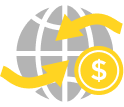Overview In 2022, Cameroon was the number 94 economy in the world in terms of GDP (current US$), the number 117 in total exports, the number 126 in total imports, the number 156 economy in terms of GDP per capita (current US$) and the number 113 most complex economy according to the Economic Complexity Index (ECI) .
Exports The top exports of Cameroon are Crude Petroleum ($2.69B), Petroleum Gas ($1.69B), Sawn Wood ($527M), Cocoa Beans ($450M), and Gold ($279M), exporting mostly to Netherlands ($1.31B), France ($1.02B), India ($974M), Spain ($683M), and China ($571M).
Imports The top imports of Cameroon are Refined Petroleum ($673M), Wheat ($316M), Rice ($304M), Packaged Medicaments ($205M), and Non-fillet Frozen Fish ($188M), importing mostly from China ($3.17B), France ($656M), India ($492M), Belgium ($330M), and United Arab Emirates ($288M).
Location Cameroon borders Central African Republic, Chad, Republic of the Congo, Equatorial Guinea, Gabon, and Nigeria by land.



